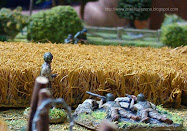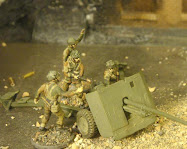
Panzer Campaigns : Normandy `44
-Help Document description.
Normandy '44 covers the D-Day invasion from June 6th 1944 and the ensuing fightHPS Simulations and John Tiller are proud to announce the release of Normandy '44, an operational level World War II simulation. Normandy '44 covers the D-Day invasion from June 6th 1944 and the ensuing fight to break out from the beachhead, insuring the complete victory
Here are some key features of "Panzer Campaigns 2: Normandy `44":
· 1 km hexes, 2 hour turns, with a master map measuring over 150 by 150 kilometers.
· Over 1500 units represent the Allied Armies versus Army Group B at mainly battalion level.
· Players control tank, reconnaissance, artillery, infantry, parachute, engineer, antitank, flak, rocket, headquarters, naval, and a wide variety of other specialized units.
· Scenarios range from a series of 55 starter and intermediate historical scenarios, up to the full 250 turn campaign game.
· Normandy '44 can be viewed in either 2d or 3d mode.
· Supports single person play against the computer, two-person hot-seat, two-person Play-By-E-Mail, and multiplayer network play over LANs and the Internet.
· Comes with Main Program, full-featured Scenario Editor, and Order of Battle Editor. · Complete on-line Help documentation plus on-line printable documentation in Microsoft Word format.
Requirements:
· Pentium-based 133mhz+ PC with 32 megabytes of RAM.
· 200 megabytes of hard drive space

 A las 18 horas antes del anochecer los sovieticos han respondido con su artilleria ligera compuesta de 11 cañones de 76mm y 12mm al norte de Olgava y la bateria de 16 morteros situada al sur de Yakhroma.´El objetivo ha sido el II del regimiento de infanteria acantonado en la villa junto a el puente objetivo. Se han producido escombros en ese pueblo. El ataque ha sido apoyado por el 243th batallón sapper soviético de a pie. La moral y la fatiga de este batallón lo ponen en predicamento si es que piensa defender el puente de Olgava.
A las 18 horas antes del anochecer los sovieticos han respondido con su artilleria ligera compuesta de 11 cañones de 76mm y 12mm al norte de Olgava y la bateria de 16 morteros situada al sur de Yakhroma.´El objetivo ha sido el II del regimiento de infanteria acantonado en la villa junto a el puente objetivo. Se han producido escombros en ese pueblo. El ataque ha sido apoyado por el 243th batallón sapper soviético de a pie. La moral y la fatiga de este batallón lo ponen en predicamento si es que piensa defender el puente de Olgava.































































































